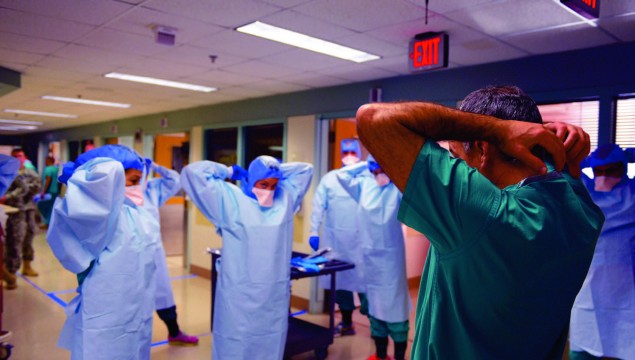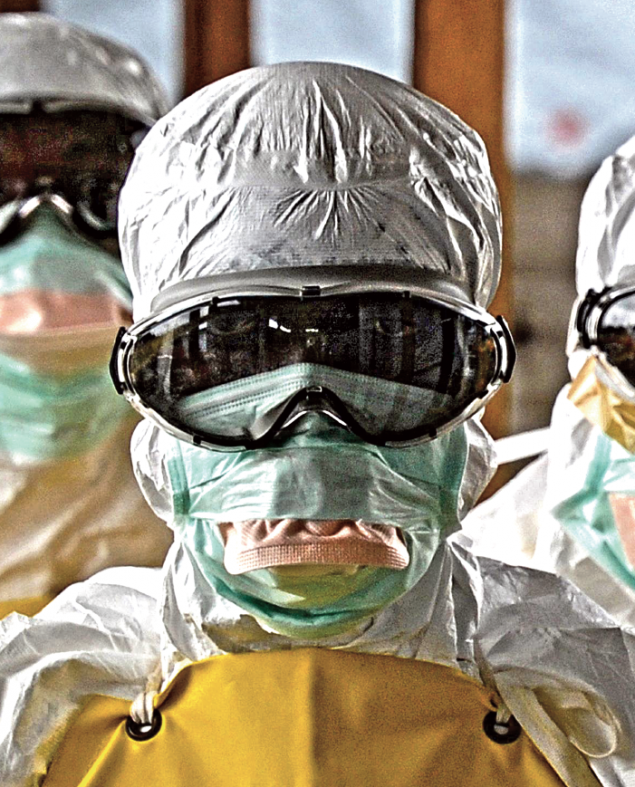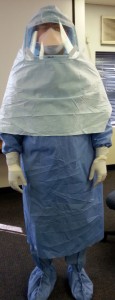Ebola: A New Disease with an Ancient Tradition
One routine day while on call in the Emergency Department, an Ebola patient presents with nausea and vomiting. Consistent with the disease, there is extensive hemorrhaging from his eyes and mouth. Suddenly his heart stops. A code red is called. I hesitate to tell you what I do next. I hesitate because I honestly do not know what happens next.
The scenario above is not a real case, but, as a practitioner of emergency medicine, it is one that I play out in my mind, and that I genuinely fear. Do I initiate CPR and expose myself to significant risk of contracting a fatal disease? Or, do I stand idly by as the blood of my patient spills, knowing that the patient will surely die?1 What would halachah say in this case?
When I first read the e-mail from the editors of Jewish Action inviting me to write an article on Ebola, I was literally on the way to my mandatory hospital Ebola preparedness training seminar. Montefiore Medical Center in the Bronx, where I work, is one of New York City’s designated Ebola receiving hospitals. As such, the opportunity to place this “Ebola scare” into a Jewish historical and halachic context is one that I welcome.
To research Ebola from a halachic standpoint, I would ask the same questions as for any medical halachic issue. Is Ebola mentioned in Tanach or the Talmud? Does Rambam or the Shulchan Aruch mention Ebola? If the answers to the above questions are in the negative, perhaps later responsa deal with the halachic ramifications of this virulent disease? As the reader will doubtless realize, the answer to all of these questions is no. The Ebola virus was only identified in 1976. Is there precedent for halachic analysis of previously unknown diseases? Yes, AIDS is a relatively new disease and has generated a fair amount of halachic literature.2 But in truth, the particular identity of the disease is not of consequence; rather, it is the issues of contagion,3 infectious disease4 and risk. Is there precedent for these issues in rabbinic literature? The answer is a resounding yes.
But why has Ebola specifically received so much attention? We have had recent outbreaks of other infectious diseases, such as mumps, measles, polio and the flu, some of these with an interesting predilection for the Jewish population.5 So why the exponentially greater response and concern for Ebola? Firstly, there is no approved therapy. Secondly, the mortality is very high, not to mention that there is no vaccine to prevent the disease. Some years ago, in the pages of this magazine, we discussed the issue of vaccination.6 In the opening lines we noted the following:
Perhaps it is because we live in twenty-first century America, a country largely immune from true epidemics, that we take vaccination for granted and some parents even consider not vaccinating their children. A Jew living in the eighteenth century would have longed for respite from the relentless onslaught of diseases, and could only have dreamed of having a way to prevent them.
This Ebola scare gives us a tiny glimpse into what life was like prior to vaccinations. Incurable, fatal diseases were rampant; death was ever-present for young and old alike; health care practitioners often risked their lives in the care of patients. Given this reality, the halachic literature already from the pre-modern era is replete with discussions relating to both the treatment of and communal response to contagious, fatal diseases.

A training session at the San Antonio Military Medical Center in San Antonio, Texas, preparing students in the event of an Ebola crisis in the U.S. Photos courtesy of the
Centers for Disease Control and Prevention/Public Health Image Library
Special prayers and fasts were instituted in times of plagues or epidemics.7 The Shulchan Aruch codifies exactly what percentage of the population needs to be affected in order to constitute a “halachic” epidemic, a passage with which modern-day epidemiologists would have a field day.8
Rabbi Moshe Isserles, the Rema (1520-1572), discusses whether one is permitted to flee the city in times of plague,9 something he himself did in 1555 when he fled from his home in Cracow due to an epidemic.10 Rabbi Yisrael Salanter (1810-1883) is reported to have made Kiddush in synagogue on Yom Kippur in order to illustrate the importance of not fasting during a cholera epidemic.11 Rabbi Yaakov Reischer (1661-1733) addressed the issue of alternative burial and the use of quicklime to hasten decomposition of the body after death from the plague to prevent contagion.12
The bikur cholim societies of previous generations, branches of the chevra kadisha, often provided medical care and assistance at the patient’s home, the primary location of care in those days. Detailed manuals were written which included protocols and guidelines for the members of the society.13 These often included a discussion regarding the visitation of patients with contagious diseases due to the inherent danger to the visitor.14 While the specific causes and mechanism of transmission of infectious disease were not clarified until modern times, there has always been an appreciation of the concept of contagion. In the 1750 manual for the Berlin Bikur Cholim Society, for example, it says, “We have accepted upon ourselves to visit all those afflicted with illness, except . . . .”15 It then proceeds to list a number of conditions thought to be contagious and life-threatening, including smallpox and measles. Our bikur cholim societies of today, updated and adapted to the modern age, are modeled after the bikur cholim organizations of the Middle Ages.
What are the halachic issues of today? Let us entertain a few fictitious scenarios and questions regarding Ebola.16 We of course pray that all this remain in the realm of fiction.
Flying
A man visited Mali on business and is concerned he may have contracted Ebola. He wants to fly to America where he will receive better treatment. May he board a plane without informing anyone of his possible illness, knowing that he may possibly infect other passengers?17 Rabbi Yitzchok Zilberstein was asked a similar question during the swine flu epidemic as to whether one who does not yet exhibit clinical symptoms of disease could fly to another city.18 In that specific case he permitted the flight, but regarding Ebola, one should consult both a physician and a rabbi before boarding.
Praying in Synagogue
A physician just returned from West Africa after treating Ebola patients and shows up in synagogue the next morning for Shacharit, where he promptly sits down right next to you. You immediately approach the rabbi and ask, “Should this man be allowed to daven in shul?” Rabbi Chaim Palaggi (1788-1869) was asked by members of a synagogue whether they could prevent a physician treating patients with the plague from praying in the synagogue out of fear that they might contract the disease. While Rabbi Palaggi said they indeed could, for the question under discussion, one should first consult with an infectious disease expert to clarify both the time frame and mechanism of contagion.
Tefillin
The local Chabad rabbi is making rounds in the hospital with tefillin in hand, looking for those who have not had an opportunity to perform the mitzvah. There happens to be a Jewish Ebola patient who is thankfully improving. The nurse informs the rabbi that everything that comes in contact with an Ebola patient has to be incinerated. May the rabbi give the patient tefillin knowing that while he will perform a mitzvah, the tefillin will be incinerated after use? Rabbi Moshe Feinstein addressed this exact question and maintained that it would be prohibited to provide the tefillin when it would lead to the destruction of the sacred Name of God.19
Financial Transactions
A man learning in the Dallas kollel supplements his income by renting out apartments. After completing a rental agreement with a tenant, he reads in the paper that this person’s sister is a nurse at the local hospital and was diagnosed with Ebola. May he renege on the contract out of fear of financial consequences? A similar question was posed to the Rema in the sixteenth century when a landlord discovered that a renter’s wife developed a contagious disease20 and wanted to rescind the contract.21 The Rema, based on an analysis of contract law, ruled that he could not, and ends with a remarkable discussion of his theory of contagious diseases.22
Circumcision
A pregnant Jewish woman is seen in the emergency department for abdominal pains. Shortly thereafter, she is contacted by the Department of Health and informed that she was exposed to a patient with Ebola. As a result, she is quarantined.23 A few days later, while still in quarantine, she gives birth to a male child. She calls her family mohel to perform the brit. Should the mohel perform the brit?24 What about performing oral metzitzah, which is his custom? This issue was addressed by posekim during the onset of the AIDS epidemic,25 and while there are similarities, this case would require a separate medical and halachic analysis.

The plague doctor costume, designed in the 1600s, was worn by plague doctors to protect themselves from contagious diseases. It consisted of a long coat and a bird-like beak mask filled with strong-smelling substances. Courtesy of Dr. Edward Reichman
Refusal to Treat
A physician receives word that his hospital is now an Ebola center. He promptly calls his rabbi and asks if he can refuse to treat such patients, or is he halachically obligated to treat them? How much risk must one accept in order to save the life of another? In halachic literature this is addressed in the analysis of the Biblical phrase, “Do not stand idly by as the blood of your brother is being shed.” Is a health care provider halachically required to endure a higher level of risk than the general population? Rabbi Eliezer Waldenberg answers in the affirmative and provides a number of reasons why, including both halachic and societal.26 He adds that when one treats patients with highly contagious diseases, one should say a special prayer in addition to the prayers a physician would generally recite that he or she should be the proper messenger of God to provide the patient’s cure.
We have briefly touched on some halachic issues related to the treatment of patients with contagious diseases. We have seen that this is not a new problem, though application of the halachah to our present case of Ebola requires a fresh medical analysis and halachic update. As to whether I would perform CPR on an end-stage Ebola patient? Let us hope that both an effective therapy and vaccine27 are developed, and that I will never need to know the answer to this question. Meanwhile, let us use this “exposure” to Ebola as an opportunity to appreciate how God has graced us with the advances in medicine that protect us from the ravages of infectious disease.
Rabbi Edward Reichman, MD, is professor of emergency medicine and professor of education and bioethics at Albert Einstein College of Medicine of Yeshiva University. Rabbi Dr. Reichman received his rabbinic ordination from the Rabbi Isaac Elchanan Theological Seminary of Yeshiva University and writes and lectures widely in the field of Jewish medical ethics.
Notes
1. For a discussion of this issue from a secular perspective, see L. Altman, “Ethicist Calls CPR Too Risky in Ebola,” the New York Times, October 20, 2014.
2. On AIDS in Jewish law, see, for example, A. Steinberg, “AIDS: A Jewish Perspective,” Medicine and Jewish Law 2 (New Jersey, 1993), 89-102; J. D. Bleich, “AIDS: Jewish Concerns,” Bioethical Dilemmas (New Jersey, 1998), 131-185; Gad Freudenthal, ed., AIDS in Jewish Thought and Law (New Jersey, 1998).
3. Notions of contagion are discussed by Biblical commentaries on the stories of Lot and Korach. See Ramban on Bereishit 19:17 and Rabbeinu Bachya on Bamidbar 16:21.
4. Some have suggested that naturally occurring infectious diseases account for a number of the Ten Plagues. For a most imaginative example, see H. M. Duncan Hoyte, “The Plagues of Egypt: What Killed the Animals and the First Born?,” Medical Journal of Australia 59 (May 1993): 706-708, who writes, “In summary, the series of disasters was: a bloom of red dinoflagellates killed the fish in the Nile, dehydration then killed the frogs, the people were attacked first by swarms of culicine mosquitoes, then by swarms of stable flies, these flies initiated an epidemic of surra in the farm animals and their bites caused an epidemic of ecthyma in the people, then there was a hail storm, a swarm of locusts and a sand storm and, the last plague of all, an epidemic of typhoid fever that killed, among many others, the Pharoh’s eldest child.”
The modern Hebrew term for anthrax is “shechin,” based on the Biblical plague, though this identification is not universally agreed upon. See L. Ben-Noun, “Characteristics of Anthrax: Its Description and Biblical Name—Shehin,” Herefuah 141:4-6 (May 2002): 124 and Z. Amar, “Shechin in the language of Chazal—What is it?” (Hebrew) Assia (January 2005): 65-69.
Also, the generic term for plague or epidemic is “dever,” derived from the Biblical plague.
5. See Albert E. Barskey et al., “Mumps Outbreak in Orthodox Jewish Communities in the United States,” New England Journal of Medicine 367: 18 (November 2012): 1704-1713. The authors attribute the rapid spread of the disease among the young Jewish population to the close contact during “chavruta” study. See Michael Orbach, “How Failure to Immunize Makes Mumps a Hazard in the Beit Midrash,” www.ou.org/life/community/mumps-hazard-beit-midrash/. See also, “Notes from the Field: Measles Outbreak Amongst Members of a Religious Community—Brooklyn, New York, March-June 2013,” Morbidity and Mortality Weekly Report 62:36 (September 13, 2013): 752-753.
6. Edward Reichman, “Halachic Issues of Vaccination,” Jewish Action (winter 2008).
7. On saying special prayers for the community during a cholera epidemic, see Chatam Sofer, Likutim b’Kobetz Teshuvot 1. Chatam Sofer in OC 1:102 also discusses the recitation of the Sanctification of the New Moon during a cholera epidemic, including the issue of psychological impact on the disease. One example of a special prayer composed for recital during an epidemic is presently on display in Jerusalem at a special exhibit at the Tower of David entitled Jerusalem: A Medical Diagnosis.
8. OC 576:2.
9. YD 116:5.
10. See the introduction to his Mechir Yayin on Megillat Esther, which he composed in exile for his father in lieu of mishloach manot, as he had insufficient funds and rations for a celebratory meal or the requisite mitzvah of mishloach manot.
11. On the variations and historical background of this oft-repeated story, see Alexander Lvov, “Rabbi Isroel Salanter, the Haskalah and the ‘Theory of Secularization’: An Analysis from a Folkloristic Point of View,” accessed December 20, 2014, lvov.judaica.spb.ru/salanter-en.shtml; Nathan Kamenetsky, Making of a Godol, vol. 1 (Jerusalem, 2004), 1104ff; Ira Taub, “The Rabbi Who Ate on Yom Kippur: Rabbi Israel Salanter and the Cholera Epidemic of 1848,” Verapo Yerapei 1 (2009): 295-313. For a recent halachic analysis of Rabbi Salanter’s actions, see Rabbi A. Weiss, “Regarding the Decision of Rav Yisrael Salanter During the Time of Plague,” (Hebrew) at http://tvunah.org/ 2013/09/10/, accessed December 21, 2014.
12. Shvut Yaakov 2:97. See also Chatam Sofer, vol. 2, YD 334. On the topic of burial on Shabbat during an epidemic, see Iggerot Moshe, YD 4:55.
13. See, for example, Sylvie-Ann Goldberg, Crossing the Jabbok: Illness and Death in Ashkenazi Judaism in Sixteenth- through Nineteenth-Century Prague (Berkeley, California, 1996); From this World to the Next: Jewish Approaches to Illness, Death and the Afterlife, (Library of the Jewish Theological Seminary, 1999), which accompanied a library exhibit.
14. Rabbi David Leiter discusses whether attending to a patient with a contagious disease might constitute a violation of self-endangerment and might even be akin to suicide. See his Beit David 22:1.
15. Aaron ben Moses Rofeh, Takanot shel Benei haHavurah deBikur Cholim (Berlin, 1750).
16. Each issue merits its own full halachic treatment, which is beyond the scope of this article.
17. See Jonathan Lapook and Scott Pelley, “2nd nurse with Ebola called CDC before boarding flight,” CBS News, October 15, 2014.
18. Rabbi Yitzchok Zilberstein, “Is a Patient with a Severe Contagious Disease Allowed to Board an Aircraft Where He May Infect Others,” in Medical Halachic Responsa, trans. and ed. Fred Rosner (Haifa, 2013), 205-207.
19. Iggerot Moshe, OC 1:4. Not only do objects that come into contact with the body require incineration, but even the bodies of patients who succumb to Ebola are cremated to prevent contagion. In Ebola, as opposed to other conditions, the body remains highly contagious after death. Cremation would be halachically problematic as it is prohibited in Jewish law. See above references to burial issues in times of epidemic.
20. The German term for the disease mentioned by Rabbi Isserles is gelbsucht, or jaundice, which refers to hepatitis.
21. Rema, She’eilot U’Teshuvot 20.
22. See the annotated edition of the Rema’s responsa by Dr. Asher Ziv (Jerusalem, 1970) for references and discussion of the Rema’s notion of contagion, as well as references to other responsa on the financial impact of contagious diseases. See also Sh”ut Maharam MiPadua 86, regarding whether a tutor can claim payment from a student who fled during the plague.
23. For a discussion about halachic issues related to quarantine, see F. Rosner, “Involuntary confinement for tuberculosis control: The Jewish view,” Mount Sinai Journal of Medicine 63:1 (January, 1996): 44-48. Rabbi Josh Flug provides references about the issue of quarantine in his “Ethical Dilemmas Relating to the Swine Flu Epidemic,” an unpublished source sheet from a shiur delivered in 2009 (available upon request).
24. If the baby was infected, God forbid, and symptomatic with Ebola, a brit would be too risky for the baby, let alone the mohel.
25. See Alfred S. Cohen, “Brit Milah and the Specter of AIDS,” Journal of Halacha and Contemporary Society 17 (spring 1989): 93-115; N. Daniel Korobkin, “Metzitzah B’peh Controversy: Rabbinic Polemics and Applying the Lessons of History,” Jewish Action (winter 2006). For an account of the position of Rabbi Moshe Feinstein, heard orally from him some two weeks before his passing, see Rabbi Avraham Cohen, Brit Avraham haCohen (1993), section Migdal Oz 8:6.
26. Tzitz Eliezer 9:17, Kuntres Refuah b’Shabbat, chapter 5.
27. Rupa Kanapathipillai, et al., “Ebola Vaccine—An Urgent International Priority,” New England Journal of Medicine 371 (December 2014): 2,249-2,251.


